If you have a Digital Workplace (DW) managed desktop computer, you have two primary options when working remotely: using your University of Toronto (U of T) laptop off-site, or using a non-U of T device. Use this web page to determine which remote work option to use, and the steps you need to take to complete any tool installations.
You can also access the Working Remotely with Managed Desktop one-pager for a condensed, shareable guide to your remote work options.
If you are not a Digital Workplace client, please reference the Working Remotely (Non-Managed Desktop) page instead. A comprehensive list of Digital Workplace clients can be found on the Digital Workplace page.
We ask that you test the option you select prior to working remotely to ensure that you have access to the services you need.
Recommended guidelines
-
If you have a University of Toronto (U of T) laptop, we recommend that you follow these guidelines.
For all U of T laptop users:
- If you have a U of T laptop, we recommend that you bring it home when working remotely. This way, the applications you need for work will already be available to you.
- If you need to access your I: or H: drives from your U of T laptop, use the UTORcsi VPN and review instructions on how to use and/or install UTORcsi.
For U of T laptop users who require access to U of T administrative systems such as ROSI or AMS/SAP:
- If you need to access secure services such as ROSI and AMS/SAP from your U of T laptop, you should use the Cisco Secure Client VPN. Review the instructions on how to access and/or install Cisco Secure Client VPN for managed desktop users.
-
If you will be working remotely on a non-U of T device, we recommend that you follow these guidelines.
For all users on non-U of T devices:
- Use Outlook Online to access your work email.
- Use the online Word, Excel and PowerPoint applications in your daily work routine.
- Store your U of T laptop files in OneDrive. You can then use OneDrive to access your work files from any device. For instructions on how to set up OneDrive, please review the OneDrive section below and the Digital Workplace OneDrive page.
For users on non-U of T devices who require access to shares, local files or U of T administrative systems such as ROSI or AMS/SAP:
- Ensure that you are enrolled with UTORMFA. If you are not, enroll via the UTORMFA Self-Enrollment page.
- Ensure that you are connected to the AdminVPN. Learn how to connect to it in the video How to connect to the AdminVPN or in the article Connecting to AdminVPN.
Service instructions
Cisco Secure Client VPN
Cisco Secure Client VPN is a general, remote access, VPN service. It connects your computer to the University’s network and protects the traffic across suspect intermediate networks such as hotels and coffee shops. When connected, all internet traffic from your computer will pass through Cisco Secure Client VPN. It can be used for easier access to library e-resources and access other services that may be restricted to general on-campus networks.
With a managed desktop computer, Cisco Secure Client VPN may already be installed. Follow the guides above to determine how to use and/or install the application.
If the VPN application is already installed
- Go to your program menu and select Cisco Secure Client.
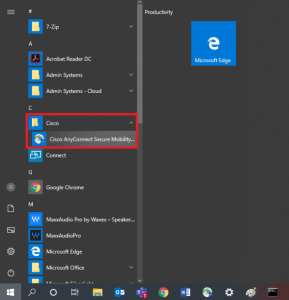
- The program will open. It should look like this:
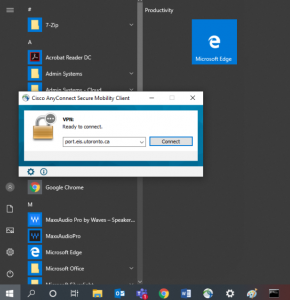
- Simply click Connect to connect to the VPN service.
- To connect to the VPN service for ROSI access, please review the instructions. To connect to the VPN service for AMS access, please review the instructions.
If the VPN application is not installed
- Submit a ticket through the Get Help form on the IT Service Centre.
- For the area where you are experiencing an issue, select End User Computing.
- For specify the area, select Other Software Installation.
- In the description, say that you need UTORvpn installed on your workplace computer.
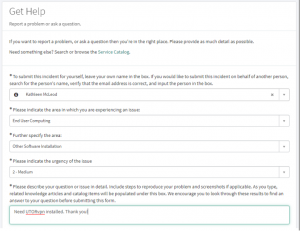
- Submit the form.
- A member of the Digital Workplace team will respond to your request as soon as possible.
OneDrive
OneDrive is a key application for you to use when you work from home: it allows you to access your computer files from any device, anywhere in the world.
To start moving your files to OneDrive, follow these steps:
- Open the online OneDrive app by logging in to your online Outlook/UTmail+ account and clicking on the waffle in the top left corner. Select the OneDrive tool.
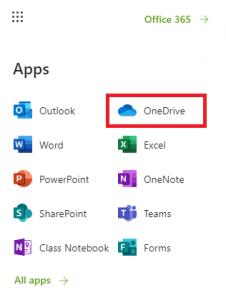
- When you open OneDrive you will see a list of all of your files that are currently uploaded.
- To add new files from your computer, simply click Upload and select whether you would like to upload Files or a Folder.
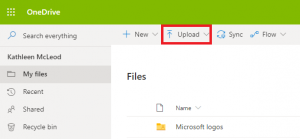
- Select the items that you would like to add and click Upload. The files will now be housed in your OneDrive!
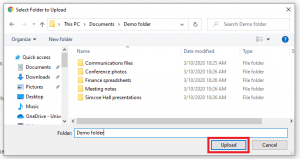
As you can see from the image, you can upload all the folder and file types you need to work from home. And you will never have to worry about running out of space – OneDrive has a storage limit of 1 TB.
If you have the OneDrive application downloaded to your computer, you can also use the sync option to ensure that any files edited on OneDrive are also edited on your computer. To learn more about this option, access this Microsoft article.
UTORcsi
UTORcsi is a remote access VPN service. It connects your computer to the University’s network and protects the traffic across suspect intermediate networks such as hotels and coffee shops. When connected, all internet traffic from your computer will pass through UTORcsi.
Using UTORcsi
If you don’t see the icon, go to Settings and click on Network & Internet. Select VPN and UTORcsi 215Huron.
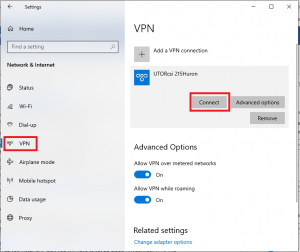
Click Connect.
If you do not have UTORcsi, please submit a ticket through the Enterprise Service Centre.
Frequently asked questions
OneDrive
OneDrive
Yes, OneDrive is secure. To learn more about how OneDrive safeguards your data in the cloud, please read this article from Microsoft.
Good news – all University of Toronto staff, students and faculty have access to OneDrive! Getting started is easy: to learn more about how you can use OneDrive at U of T, visit EASI’s OneDrive page.
Access OneDrive training through the University’s SuccessFactors website.
You do not need to use a VPN to access your files on OneDrive. You can use the Microsoft web interface to securely access your OneDrive files from anywhere in the world.
The simplest option for accessing your work files from home is to upload them to OneDrive. OneDrive is available to all staff, students and faculty at the University of Toronto, and you can access it through the Office 365 web interface.
To learn how to upload your computer files to OneDrive before you work from home, access OneDrive training through the University’s SuccessFactors website.
Using Microsoft 365 remotely
Using Microsoft 365 remotely
If you get this message, simply click Cancel and relaunch the Teams app.
Yes, people can now dial in to University of Toronto Teams meetings via phone. For more information on how this works, please reference the FAQ page.
University of Toronto community members have access to online versions of Microsoft Office applications like Word, Excel and PowerPoint. To learn more about how to access these tools through the web, visit uoft.me/dwO365.
When working from home, you can access your University email from any device by using the UTmail+/Outlook web client. If you have not used Outlook Online before, you can learn how to access it through the U of T Digital Workplace UTmail+ page.
Yes. You can access SharePoint from any web browser on any device.
Additional questions
Additional questions
You can absolutely work from home on your U of T computer. Access ROSI and other administrative tools with AdminVPN and UTORMFA.
You should use a VPN when:
- You do not have access to a home computer, but could bring your work laptop home. In this instance, you would use Cisco Secure Client VPN to access secure systems such as ROSI and AMS/SAP.
- You have your U of T computer at home, but you need access to your I: or H: drives. In this instance, you would use UTORcsi.
- You need access to specific departmental shares.
The work from home option you select will be determined by whether you have a U of T laptop that you can bring home.

